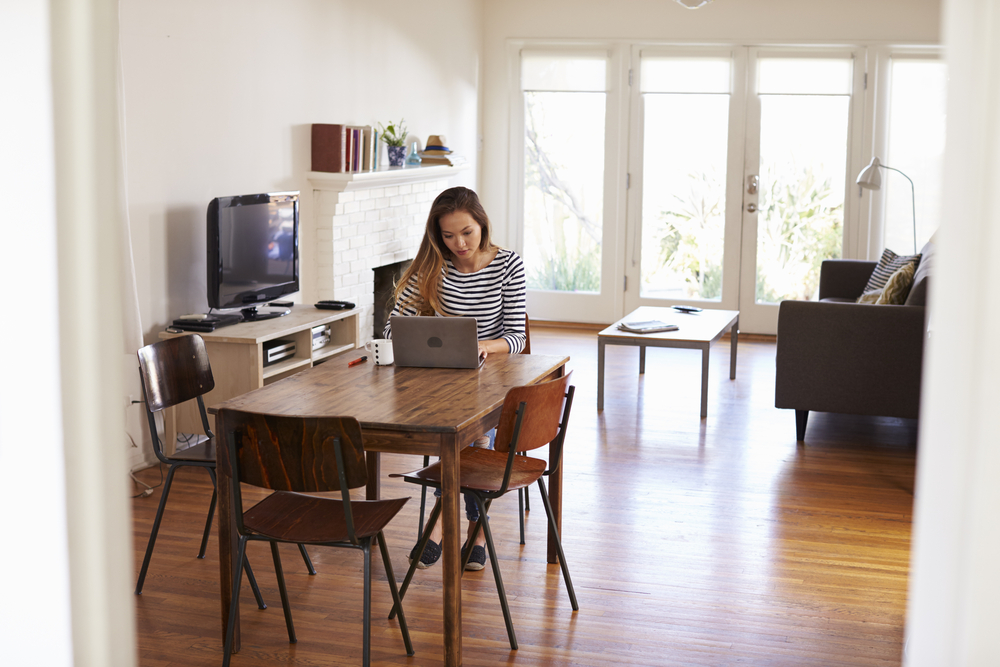Looking to do a bit of spring cleaning? Your office space might be in dire need of an update. If you suffer from back aches, eye strain, and more, it might be how your desk is set up. An ergonomic desk setup means to design for efficiency and comfort. So, reconfiguring your office workstation is setting you up for future success. Now, it may sound like an oxymoron to make sitting all day in front of a screen comfortable. However, these seven tips are sure to create the ultimate working environment.
Chair height
The basics to comfort are setting your chair up to promote the best posture. Adjust the height of your chair so that your knees are level with your hips. When you do this, your arms should rest on the desk at 90 degrees or a right angle. The only downside is that the average desk height is 29 to 30 inches tall, so your feet might not touch the ground. To prevent foot strain we recommend investing in a footrest.
Office chairs are not always the most comfortable either. Sometimes they feel like leaning against a concrete wall for hours on end. So, consider buying pillows that support your lower back and fit the natural curve of your spine.
Screen distance
The reason you could be hunching over is because the screen is in the wrong place. You want the laptop, desktop, or monitor to be arm’s length away. Stick your arm out straight in front of you and the tips of your fingers should brush against the screen. The next step is bringing it up to your eye level. If the screen is too far down, you will hunch over. Adjust the laptop, desktop, or monitor so that the top of the screen is an inch or two below your eyebrows. You can do this with a laptop stand, desk shelf, or reams of paper.
For those working on two monitors, consider how you use them. If you mainly work on one monitor and the other supports it, then put the second one off to the side of the primary monitor. It should be on the side of your non-dominant hand to allow space for you to write. If both monitors are equally important, then position yourself between them. When you look straight ahead, your eyesight and keyboard should face the gap between the monitors.
Keyboard and mouse placement
The key to an ergonomic desk setup is not to reach for anything. Everything should be easily accessible, especially your mouse and keyboard. If you move your laptop onto a stand to fit your eye level, then the keyboard is not out of reach. An external mouse and keyboard will help you maintain good posture. For any keyboard, it should sit below your hands without straining your wrists. Then, the mouse is placed next to the keyboard and should comfortably fit in your hand. Your fingers should not drape over the edges of the mouse nor should they be struggling to hold it.
Phone placement
If you are cradling the phone between your ear and shoulder to type, then that’s probably the reason your neck aches. Invest in a headset or headphones that allows you to listen to the caller with your hands free. The other thing to help prevent neck pain is to place the phone on your non-dominant side. This way your dominant hand can freely take notes.
Lighting
Eye fatigue happens when our eye muscles are working hard for a prolonged period of time to focus the image. It can be triggered by screen time, too bright or dark lighting, driving for a long time, etc. Your workspace should help your eye muscles not strain them. Allow lots of natural light in from windows or turn on lamps that cast light over the entire desk.
If you are feeling eye fatigue, consider blue light glasses, periodically looking at something in the distance, or taking screen-free lunch breaks. For more information, read research on eye strain done by the University of Arizona.
Objects of happiness
Plants, family photos, pet photos, stress balls, plushies, or other nicknacks that spark joy will make your workstation more enjoyable. No one wants to be surrounded by gray, blank walls for the majority of the day. Bring pops of color, items that inspire your creativity, or stress relievers. Anything that makes the space feel welcoming and personal is key.
Take short breaks
Chugging through the workday with only lunch as your break will lead to burnout fast. We all need a bit of time to refresh and get the blood moving again. Take about two to four short breaks that last about five or more minutes throughout your day. Each break should help you relax your eyes and move your body. It can be as simple as getting up for a cup of coffee or chatting with a coworker about an upcoming meeting. If you are looking for a little more exercise in your routine then watch this video from the Wall Street Journal where certified personal trainer, Donovan Green, shows a few moves to do at your desk.
Want to learn more tips? Read more IAW articles such as simple in-office health habits or how to set boundaries between work and home.




